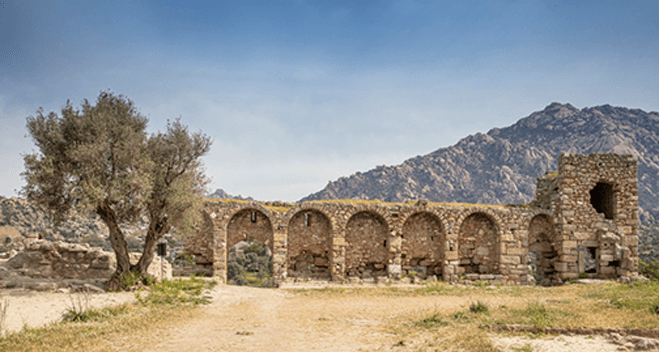The city is located within the present-day village of Kapıkırı, 39 km from Milas. Although geographically located on the border of Ionia and Caria, and even in the Ionia region, it is considered a typical Carian city with its character and historical past.
It took its name from the famous mythological hero Herakles.
In the 8th century BC, its name was Latmos, but during the Persian period it fell into the hands of the Carian Satrap Mausolus. As a result of Alexander's Asian campaign, it was annexed to the Alexander Empire, and later to the Seleucids. Losing its former importance after its connection with the sea was cut off in the 1st century BC, Herakleia became a hiding place for Christian monks due to the difficulties in transportation.

The ancient city, built on a very rugged and rocky terrain, is surrounded by a 6.5 km long rampart reinforced with 65 towers. The ramparts, which display regular rectangular and square stonework, were built in the Hellenistic Period. Herakleia, which was settled according to the Hippodamos city plan, is one of the examples of the well-implemented grid-shaped parcel and street plan that intersect each other at right angles.
The Temple of Athena, located on the rocky terrain behind the harbor, is one of the best-preserved structures of the city. It is a two-columned Hellenistic Age structure in the Templum in Antis style. The agora located to the east of the Temple of Athena has two floors, the first floor of which still stands today. The locations of the shops and inns in the agora are clear. The walls on the south side display very beautiful stonework. It is rectangular in plan and is surrounded by porticoes. The angular “U”-planned structure to the east of the agora is the Bouleterion. The northeastern perimeter walls of the structure are in very good condition.

The theater is located in the northeast of the city. The walls of the skene building and the rows of seats belonging to the first cavea can be seen. The apsidal cella and pronaos of the Endymion Sanctuary, located on the side of the road leading to the city's coast and the islands, can be seen. According to mythology, the Moon Goddess Selene falls in love with the beautiful young man Endymion, who was a shepherd in the Latmos Mountains, and condemns him to eternal sleep.
The frescoes decorating the ceilings and walls of these hermitages depict the life of Jesus, the Virgin Mary and the Saints. The surface survey conducted by the German Anneliese PESCHLOW in the Ancient City of Herakleia continues every year.
Since 1991, studies have been carried out to examine the settlements in the part of the mountain that remains within the borders of the ancient city of Herakleia. Within this scope, the existence of a very old rain and rock cult on the summit was taken into consideration and prehistoric ruins were investigated with a specific goal. Today, 170 rock paintings are known in Latmos, where the first rock paintings were found in 1994.


